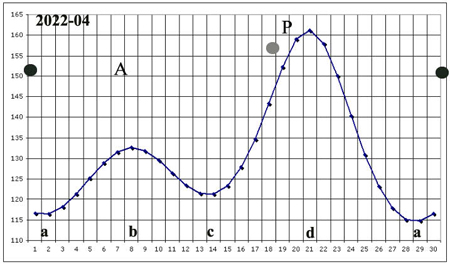The secret of life on Earth.
For the most part, the Moon's angular motion, relative to the Earth, is usefully characterized by a cycle, within which there are two alternating phases, the cumulative phase and the dissipative phase.
During a cumulative phase, said motion is increasing, while during the dissipative phase, said motion is decreasing. This two-phase variation of the Moon's angular motion, around the Earth, is among the conditions of life on our planet.
This two-phase variation (cumulative and dissipative) among other things allows seeds to occasionally recover a degree of ability to germinate, thus being able to remain germinable for a long time.
The graph of the Calendar.
The calendar of the cumulative-dissipative cycle of seeds, which I have developed, is built on the difference between the speed at which the Earth is rotating on itself, and the angular velocity of the Moon around the Earth.
Therefore, the calendar indicates the cumulative phase when the curve goes down (sectors b-c and d-a), and the dissipative phase when the curve goes up (sectors a-b and c-d).

The mechanism of cumulative-dissipative processes.
The variation of the angular velocities of the Moon around the Earth makes the mechanism of cumulative-dissipative processes possible.
This mechanism begins during the cumulative phase, where there is a partial reduction in the configurational order of the molecules.
All this is aimed at returning to the original order in the subsequent dissipative phase, with a decrease in entropy, on average without causing degradation of the energies in the universe, thus circumventing the second law of thermodynamics. (experiments A and E)
Adequate magnetic field.
Furthermore, our planet is provided with an adequate magnetic field, which, as said before, could prove to be essential in the interactions of this force, due to movement.
If this hypothesis were confirmed, on the Moon and on Mars, without a suitable magnetic field, the processes that this force would allow could not take place.
Establishing farms on the Moon and Mars, as some already plan to do, could then present problems that are difficult to solve, and in any case extremely expensive, in relation to the results.
There is no Earth B.
Without degrading energy, the “force d” allows to lower entropy in seeds, at the top of what allows downstream the conditions for life. I have reasons to believe that cumulative-dissipative processes take place also in water, which is at the same top (see part 2, on ocean tides).
All this with implications on the status of the Earth, as the only place, in the solar system, where life can develop. In other words, as rightly said, there is no Earth B.